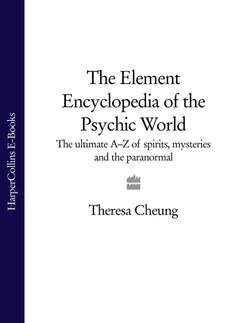Читать книгу The Element Encyclopedia of the Psychic World: The Ultimate A–Z of Spirits, Mysteries and the Paranormal - Theresa Cheung, Theresa Cheung - Страница 88
BACHELOR’s GROVE CEMETERY
ОглавлениеA small, abandoned cemetery that is overgrown, unkempt and subject to vandalism, Bachelor’s Grove Cemetery is one of Chicago’s most haunted sites. It is located on the edge of the Rubio Woods Forest Preserve, near the suburb of Midlothian, Illinois. There have been over a hundred paranormal incidents reported here, including inexplicable lights and voices, apparitions, strange photos, anomalous recordings and even sightings of magical creatures.
The first burial took place in 1844, but it wasn’t until 1864 that the cemetery became known as Bachelor’s Grove. This may have been because around this time a group of German immigrants, hired to help build the Illinois-Michigan Canal, settled on small farms nearby, and most of these settlers were unmarried men. Burials became less frequent in the 1960s, and the last recorded burial was in 1989.
It was in the 1960s that stories of hauntings began. Unfortunately, this was also when the vandalism and desecration began, and today the cemetery is in a terrible condition. Vandals have left few of the graves still standing, and many tombstones have been stolen or dumped elsewhere, giving rise to legends that the gravestones sometimes move by themselves.
The reporting of strange phenomena peaked in the 1970s and 1980s, but hauntings continue to be reported to this day, including flashing lights and phantom vehicles. The strange lights are said to be red or blue in colour, dancing just out of reach of those who chase them, as if the lights had an intelligence of their own. Phantom cars appear and disappear on the cemetery path. One couple even had a car crash with a vehicle that vanished before their eyes, leaving their own untouched despite the sounds of bending metal and breaking glass.
The most-often reported apparition at Bachelor’s Grove is a vanishing house or floating house. Access to the cemetery is gained by way of a narrow gravel trail that was once a main road through the area. Along this trail, many visitors have reported seeing a phantom farmhouse that seems to appear and disappear at random. The house is always seen from a distance and described in the same way, as a white house with porch pillars, a swing and a soft light burning in the window, but it is never reported in the same place. As witnesses approach the house, it shrinks and disappears. According to legend, anyone who succeeds in entering the house will never return.
Just past the fence surrounding the cemetery is a small lagoon that borders the nearby turnpike road. This pond was a favourite corpse dumping ground for Chicago gangsters during the years of Prohibition, so it isn’t surprising that the pond is thought to be haunted. One ghost linked to the lagoon is said to be a two-headed man, reported on many occasions. Others report seeing a ghostly farmer who was pulled into the water by his plough and horse in the 1870s. The horse was drowned by the weight of the plough, taking the farmer with it.
Still others report seeing people dressed in monks’ robes, and in 1984 the vision of a glowing yellow man was reported. In the 1990s several people reported seeing a large black dog near the entrance, which would vanish as people appeared, perhaps as a warning to go no further. The most famous ghost is the ‘White Lady’ or the ‘Madonna of Bachelor’s Grove’, who has been seen on nights of the full moon, wandering the cemetery with a baby in her arms. She is said to be the ghost of a woman buried there, next to her young son.
Paranormal investigators have reported electronic voice phenomena at Bachelor’s Grove, with the names of those buried there being called out repeatedly. There have been many attempts to capture Bachelor’s Grove phenomena on film, and plenty of photographs exist with images resembling ectoplasm. Perhaps the most famous photograph of Bachelor’s Grove was taken in 1991 by Mari Huff, a member of the Ghost Research Society. It shows a waiflike transparent young woman dressed in old-fashioned clothes sitting on a crumbling tombstone. According to Huff, this woman was not visible when the picture was taken. Sceptics argue that the photo is a double exposure, but a number of professional photographers do believe it to be genuine.
